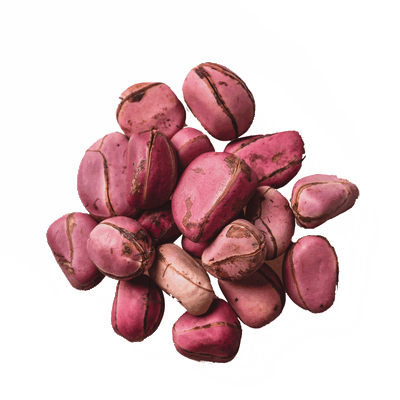
Oko: The Orisha of Agriculture, Harvests, and Fertility
Orisha Oko (also known as Orishaoko or Orishaoco) stands as a guardian and patron of the earth's fertility, ensuring the prosperity of crops and the well-being of those who cultivate them. His influence in the Yoruba tradition goes beyond mere agricultural productivity; he symbolizes the growth and nourishment of entire communities, embodying the harmony between humans and the natural world. This exploration of Orisha Oko will take us through his origins, symbols, relationships with other Orishas, and the rituals that honor him, providing a deeper understanding of his vital role in the Yoruba religion, Santeria, and beyond.
Who is Orisha Oko?
Orisha Oko is an important deity in the Yoruba religion, primarily associated with agriculture, fertility of the land, and the harvest. Unlike Elegua, who is the master of crossroads and destiny, Orisha Oko's domain is the vast fields and the bounties they yield. He is revered as a provider, ensuring the fertility of the earth and the abundance of crops.
Orisha Oko's role in agriculture is not just about the physical growth of crops but also symbolizes the growth and sustenance of communities. He is seen as a nurturing force, vital for the well-being and survival of the people.
As the guardian of agriculture, Orisha Oko's presence is believed to be essential for successful farming and bountiful harvests. He is invoked by farmers and those reliant on agriculture for blessings on their land and crops.
The deity's influence extends beyond mere crop growth. He is associated with the cycles of nature, the changing of seasons, and the balance between human activities and the natural world. His blessings are sought to ensure harmony between the earth and those who cultivate it.
Oko’s Birth, Decent, Disappearance, and Return
The origins of Oko are closely tied to Yemaya, the Yoruba goddess renowned for her dominion over water and motherhood. Born from Yemaya, Oko's journey is a testament to his divine heritage. His descent to Earth, taking human form, marked the beginning of a profound legacy. Settling on a humble farm, Oko's deep connection to agriculture was evident as he nurtured the soil, resulting in an extraordinary yield of crops, symbolizing fertility and abundance.
Yet, Oko's earthly existence took a mystifying turn. He disappeared without a trace, leaving behind his staff firmly rooted in the ground. This mysterious event caught the attention of his neighbors, who witnessed the remarkable energy radiating from the spot. It was this extraordinary occurrence that elevated Oko to a higher status. The local community, struck by the enigmatic power and significance of this event, began to venerate Oko as a deity. He was revered as the god of agriculture and fertility, a testament to his impact and the mysterious circumstances surrounding his disappearance and subsequent deification.
Orisha Oko’s Appearance and Symbols
Orisha Oko is a divine representation of agriculture and the earth's fertility, often depicted in attire that deeply resonates with his role as a deity. His clothing, featuring earthy tones of green and brown, reflects the fertile land and the abundance of crops it produces. These colors, along with his traditional farmer's attire, symbolize the nurturing spirit of the earth, while practical items like hats or head wraps denote his connection to the daily toil of cultivation.
The adornments of Orisha Oko's attire serve as more than mere reflection; they are symbols of the harvest itself. Yams, grains, and vegetables embellish his clothing, highlighting his integral role in fostering bountiful harvests and symbolizing a palpable link to the cycles of growth and prosperity that sustain life.
Orisha Oko's iconography is rich with symbols that further cement his authority over agriculture. The white African yam is a significant emblem, representing his crucial role in the yearly harvest and in providing sustenance. Oko's tools of the trade—hoes, plows, and sickles—embody the labor and skill inherent in farming, while the colors of his domain, particularly the vibrant greens and deep browns, represent the essence of his being, mirroring the earth's life force and the green growth it supports. Moreover, the presence of crop imagery, especially yams and other staples, in his representations, is not just for looks. They are potent symbols of life's sustenance, embodying the endless cycle of nourishment, abundance, and the continuous growth and harvest overseen by Orisha Oko.

The balance between Oshun's rivers and Oko's earth is key to successful harvests and abundance.
Orisha Oko's Relationships with Other Orishas
Orisha Oko's relationships with other deities in the Yoruba tradition are integral to his role as a guardian of agriculture. These relationships not only enhance his connection to agriculture but also symbolize various aspects crucial for the success and sustainability of farming practices.
Oshun's Fertility Dance with Orisha Oko
The relationship between Oshun and Orisha Oko represents the harmonious balance between water and earth. Oshun, often associated with rivers, streams, and freshwater, symbolizes fertility, love, and abundance. Her waters are essential for irrigating the fields and ensuring the fertility of the crops. The balance between the fluidity of Oshun's rivers and the solidity of Orisha Oko's earth is key to successful harvests and agricultural abundance.
Yemaya's Role in Agricultural Bounty
As the goddess of the ocean, Yemaya's connection with Orisha Oko extends the importance of water in agriculture to a larger scale. She represents the vastness of water sources, including rains and underground water that nourish the land. This relationship emphasizes the broader environmental considerations necessary for farming, reminding practitioners of the interconnectedness of natural elements and the need for sustainable agricultural practices.
Ogun's Contribution to Farming's Strength
The deity of iron and war, Ogun's relationship with Orisha Oko symbolizes the tools and physical labor required in agriculture. Ogun provides the necessary tools for tilling, planting, and harvesting, representing the technological and human effort aspect of farming. This connection also highlights the resilience and strength needed by farmers, as well as the transformative power of agriculture in shaping landscapes and communities.
Together, these relationships of Orisha Oko with Oshun, Yemaya, and Ogun depict a comprehensive view of agriculture in the Yoruba belief system, where spiritual, environmental, and physical elements are all vital for the prosperity and sustainability of farming and the community's well-being.
Orisha Oko: Judge of the Other Orishas
Orisha Oko holds a significant role in the Yoruba tradition as the judge of the Orishas. His position as a judge symbolizes his ability to mediate and resolve disputes, upholding justice and fairness within the community. Orisha Oko's distaste for arguments reflects a deeper value of harmony and peace.
His promptness to defend females in the face of arguments highlights his protective nature, especially towards those who might be seen as more vulnerable in conflicts. This characteristic underlines his commitment to safeguarding fairness and preventing injustice.
In disputes, especially those involving allegations of evil magic or witchcraft, Orisha Oko serves as an arbitrator, ensuring that truth and justice prevail. His role is crucial in maintaining the moral and ethical balance within the Yoruba spiritual framework.

Orisha Oko is a divine representation of agriculture and the earth's fertility.
Oko Rituals for Fertility, Nature Connection, and Healing
Embarking on a spiritual journey often involves rituals that help connect us to deeper meanings and purposes. Presented here are three distinct rituals, each with its unique focus and methodology, to aid in seeking fertility and abundance, connecting with nature, and attaining healing and cleansing. These practices draw on the ancient wisdom of Orisha Oka, guiding you through steps to fulfill your spiritual needs.
Ritual for Seeking Fertility and Abundance
This ritual calls upon Orisha Oka for blessings in fertility and abundance. It’s a way to seek guidance and help in growing your family or enriching your life with prosperity. Here is what you will need to perform this ritual:
- Green candles
- White Lavender oil
- Small bowl of rice
- A glass of water
- White cloth
To conduct this Oko ritual for seeking fertility and abundance, start by finding a peaceful, quiet space. Once you've found the right spot, lay a white cloth on a table. This will serve as your ritual's sacred space. Next, place green candles in the center of the cloth. These candles represent growth and abundance, so light them to invite these energies into your life. After lighting the candles, take a moment to anoint each one with a few drops of white lavender oil. While doing this, set your intention clearly in your mind, focusing on what you wish to achieve in terms of fertility and abundance.
Now, place a bowl of rice in front of the candles. Rice is a powerful symbol of prosperity and fertility, aligning with the purpose of your ritual. Beside the bowl, put a glass of water. This element represents life and purity, essential components in your quest for abundance and fertility.
With your ritual setup complete, close your eyes and concentrate on your intentions. This is a personal and powerful moment—speak your wishes out loud or silently in your heart, whichever feels right. Allow the candles to burn for a while as you meditate on your desires, letting the energy of your intentions fill the space around you.
Conclude your ritual by gently blowing out the candles, a gesture that signifies the end of your ceremonial practice. As you do this, express your gratitude to Orisha Oka, thanking the deity for their presence and assistance in your ritual. This act of thankfulness is a crucial part of the ritual, as it acknowledges the spiritual support you've sought and received.
Ritual for Connecting with Nature
This ritual is designed to deepen your connection with nature and Orisha Oka, who is closely associated with the natural world. Gather the following items before beginning this ritual:
- Blue candles
- Pineapple oil
- A pot of soil
- Obi seeds
- A feather
To perform this Oko ritual for connecting with nature, begin by selecting a tranquil outdoor location, or if indoors, choose a spot near a window that offers a view of the natural world. Once you've settled into this space, set blue candles on the ground, representing elements of the sky and water. Light these candles to symbolize the connection between these natural forces and your ritual. Next, anoint the candles with pineapple oil. This act is not just a ritualistic gesture but a way to deepen your bond with the natural world, infusing the space with the essence of nature.
Now, take a pot of soil and place it gently between the candles. The soil signifies the earth, grounding your ritual in the very essence of nature. Proceed by planting the Obi seeds in this soil. This step is a symbolic gesture, representing the growth of your connection with nature. As you plant the seeds, visualize your relationship with the natural world flourishing and deepening.
After planting the seeds, place a feather on the soil. This feather symbolizes the freedom and beauty inherent in nature, adding another layer of symbolism to your ritual. With all elements in place, spend a few minutes in quiet contemplation. During this time, immerse yourself in the sensations around you, feeling your connection to the earth and the natural environment deepening.
To conclude the ritual, take a moment to express your gratitude to Orisha Oka for the connection and insights gained. Gently blow out the candles, marking the end of your ceremony. This final step not only signifies the completion of the ritual but also your respect and thankfulness for the natural world and its many gifts.
Ritual for Healing and Cleansing
This ritual is to seek Orisha Oka's help in healing and cleansing, whether it's physical, emotional, or spiritual healing you need. The following ingredients are what you will need to perform this ritual:
To embark on this Oko ritual for healing and cleansing, begin by finding a serene space where you won't be disturbed. This peaceful environment is crucial for your focus and the effectiveness of the ritual. Once you've found the right spot, place white candles on a table. These candles are not just for light; they symbolize purity and healing. Light them to set the tone for the ritual and to invoke healing energies.
After lighting the candles, anoint each one with healing oil. As you do this, concentrate on your specific needs for healing and cleansing. The act of anointing is a way to personalize the ritual, imbuing the candles with your intentions. Following this, take a handful of sea salt and sprinkle it around the candles, forming a circle. Salt has long been recognized for its cleansing properties, and this circle acts as a barrier, keeping negative energies at bay while enhancing the purification process.
Next, lay fresh basil leaves in front of the candles. Basil, known for its protective and healing properties, adds a layer of significance to your ritual. After setting up the basil, take a small bell and gently ring it three times. The ringing of the bell is a powerful act that helps to clear negative energies and invites positive, healing vibrations into your space.
Now, sit quietly and focus on your healing intentions. This meditation is a time for you to connect deeply with your inner self and the healing energies you have invited. Allow yourself to be surrounded and soothed by these energies, fostering a sense of peace and well-being.
Conclude your ritual by expressing gratitude to Orisha Oka for the healing energy provided. Then, gently extinguish the candles. Blowing out the candles signifies the end of your ritual, marking a return to your regular state of being, hopefully, refreshed and cleansed.
Orisha Oko plays a vital role in the Yoruba religion as a deity of agriculture and fertility. He is a symbol of the sustenance provided by the earth and the balance between human beings and nature. His presence ensures not only the physical growth of crops but also the spiritual and communal growth of those who revere him. By honoring Orisha Oko, followers seek to maintain a harmonious relationship with the land, celebrating the cycles of nature and the bounty it provides.













